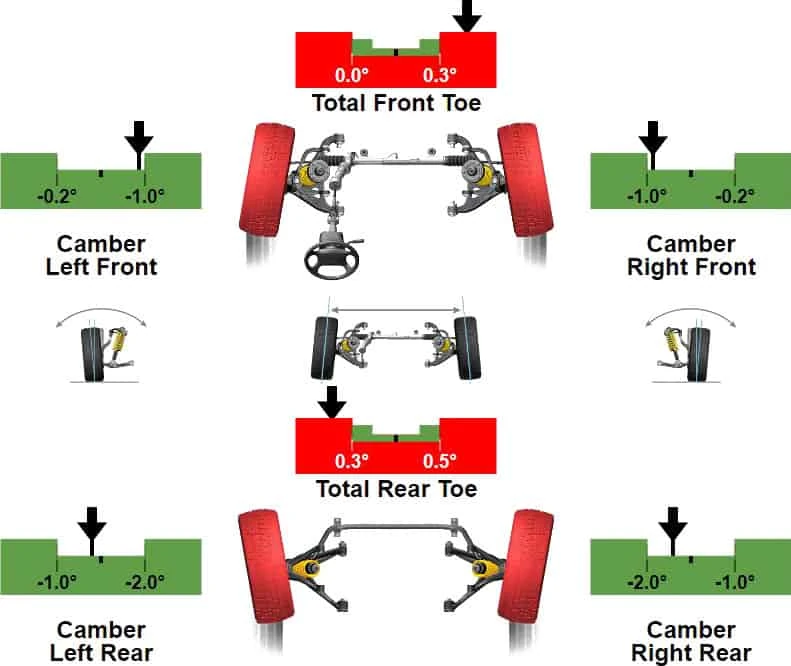What Is Wheel Alignment?
Wheel alignment, also called tire alignment, refers to adjusting the angles of your vehicle’s wheels to the manufacturer’s specifications. Proper alignment ensures your tires meet the road at the correct angle, your wheels are pointing straight, and your suspension components are in harmony.
Key Alignment Angles:
- Camber – The inward or outward tilt of the tire when viewed from the front. (Excessive tilt causes uneven wear.) (Source: Bridgestone Tires)
- Toe – The extent to which tires turn inward or outward (like pigeon-toed or duck-footed). Incorrect toe is a major cause of premature tire wear. (Source: KNBService)
- Caster – The angle of your steering axis when viewed from the side. Affects steering stability and cornering. (Source: Firestone Complete Auto Care)
Why It Matters: Misaligned wheels force your tires to work against each other, reducing efficiency, safety, and tire lifespan. The NHTSA notes that proper alignment is critical for optimal tire performance and accident prevention.
Pro Tip:
Alignment specs vary by vehicle—always refer to your owner’s manual or a certified technician. Modern cars often require four-wheel alignments (even for front-wheel-drive vehicles).
Signs Your Vehicle Needs a Wheel Alignment
Ignoring wheel misalignment can cost you hundreds in premature tire replacement and fuel waste. Watch for these 6 red flags:
1. Uneven or Rapid Tire Wear
Check for:
- Feathering – Tread ribs feel smooth on one edge, sharp on the other.
- Camber wear – Excessive wear on one side of the tire (inner/outer edges).
- Toe wear – Saw-toothed tread pattern, often with a grainy feel. (Tire wear patterns explained)
2. Vehicle Pulls to One Side
If your car drifts left/right without steering input on a flat road, misalignment is likely. Test: Briefly release the wheel (safely) at low speed. (Consumer Reports diagnostic tips)
3. Off-Center or Vibrating Steering Wheel
A crooked steering wheel when driving straight or vibrations at highway speeds signal alignment issues. Note: Vibrations may also indicate unbalanced tires—a technician can diagnose the difference.
4. Squealing Tires
Misaligned tires scrub against the road surface, causing high-pitched noise, especially in turns. (Michelin: Causes of tire noise)
5. Reduced Fuel Efficiency
Misalignment increases rolling resistance. The U.S. DOE estimates proper alignment improves gas mileage by up to 10%.
6. Loose or Unresponsive Steering
Excessive play in the wheel or delayed response can stem from severe misalignment or worn suspension parts.
When to Check Alignment:
- After hitting potholes/curbs
- Every 6,000 miles or with oil changes (whichever comes first)
- When installing new tires
Benefits of Regular Wheel Alignment
Proactive alignment isn’t just about fixing problems—it’s a cost-saving maintenance habit with measurable performance and safety perks. Here’s what you gain:
1. Improved Fuel Efficiency
Misaligned wheels create drag, forcing your engine to work harder. Studies by the U.S. Department of Energy show proper alignment can improve gas mileage by 2-10%—saving $100+ annually for the average driver.
Key impact: Just 0.1° of toe misalignment increases rolling resistance equivalent to driving with underinflated tires at 5 PSI.
2. Longer Tire Life
Alignment extends tire lifespan by 20-50% (USTMA). For a set of $800 tires, that’s $160–$400 in savings.
- Prevents scalloping/cupping: Irregular tread wear from misalignment destroys tires prematurely.
- Even wear patterns: Properly aligned tires degrade uniformly, maximizing tread depth.
Real-world example: A Consumer Reports test found aligned tires lasted 30,000 miles vs. 18,000 miles on misaligned vehicles.
3. Better Handling & Stability
Precision alignment enhances:
- Steering response: Reduced wheel fight improves cornering accuracy.
- Road feedback: Proper caster angle maintains straight-line stability, especially critical for EVs (heavier weight demands precise alignment).
SAE International research confirms optimized alignment reduces driver corrective actions by 15%.
4. Safer Driving Experience
The NHTSA links proper alignment to:
- Shorter braking distances: Even tread contact improves traction.
- Hydroplane resistance: Correct toe/camber prevents water channeling issues.
- Emergency maneuver reliability: Predictable handling during swerves.
Crash prevention: A 2022 AAA Foundation study found vehicles with misaligned wheels were 2.3x more likely to fail evasive steering tests.
Pro Maintenance Tip:
Pair alignments with tire rotations every 5,000–7,500 miles (check your manual). This combo maximizes all benefits.
How Often Should You Get a Wheel Alignment?
Unlike oil changes, alignment isn’t strictly mileage-based. Follow this data-driven guide to optimize timing and avoid wasting money:
Standard Recommendations
- Every 12,000 miles (20,000 km) or annually – Whichever comes first (Bridgestone)
- With every other oil change – For drivers averaging 15,000 miles/year (Firestone)
- When installing new tires – Ensures even wear from day one (saves $200–$500 over tire life)
High-Risk Scenarios (Check Immediately)
Get an alignment within 100 miles after these events:
- Hitting a pothole/curb at 20+ mph (can bend suspension components)
- Off-road driving – Rough terrain knocks wheels out of spec
- After suspension work – Replacing shocks, struts, or control arms
Warning Signs You’re Overdue
If you notice any of these, schedule alignment within 1 week:
- Steering wheel off-center by more than 5 degrees when driving straight
- Uneven tire wear exceeding 2/32″ depth difference across tread
- Vehicle drifts >3 feet during a 100-foot straight test (find empty parking lot)
Vehicle-Specific Factors
| Vehicle Type | Alignment Frequency | Why? |
|---|---|---|
| Performance Cars (Sports cars, EVs like Tesla) | Every 6,000 miles | Lower-profile tires show wear faster; precise handling critical |
| Trucks/SUVs | Every 10,000 miles | Heavier weight stresses suspension |
| Older Vehicles (10+ years) | Every 6 months | Worn suspension components lose alignment faster |
Pro Tip: The 3-Month Test
Check alignment quarterly with this free DIY method:
- Find a straight, flat road with minimal traffic
- Drive at 40 mph, briefly release steering wheel (safely)
- If vehicle drifts >1 lane width in 5 seconds, alignment needed
Note: Crosswinds can affect results—test multiple times.
Final Advice: Modern alignments cost $75–$200—far less than replacing $800 tires prematurely. When in doubt, consult your vehicle manual or a ASE-certified technician.
Wheel Alignment vs. Wheel Balancing: What’s the Difference?
Over 60% of drivers confuse these services (AAA survey). Here’s the definitive breakdown to prevent costly maintenance mistakes:
| Wheel Alignment | Wheel Balancing | |
|---|---|---|
| Purpose | Adjusts wheel angles to manufacturer specs | Equalizes tire/wheel weight distribution |
| Addresses | Camber, toe, and caster angles | Heavy spots on tire-wheel assembly |
| Tools Used | Alignment rack with laser/camera sensors | Balancing machine with spin adapters |
| Symptoms Fixed | Vehicle pulling, crooked steering wheel, uneven tire wear | Steering wheel vibration (usually at 50-70 mph) |
| When Needed | After impacts or every 12,000 miles | With new tires or when vibration occurs |
| Cost Range | $75-$200 (4-wheel) | $15-$50 per wheel |
Key Differences Explained
Wheel Alignment: The Angle Specialist
Alignment focuses on suspension geometry:
- Corrects three angles: camber, toe, and caster
- Requires specialized equipment (modern shops use 3D imaging)
- Takes 45-90 minutes for precision adjustments
Real-world analogy: Like adjusting a door frame so the door swings perfectly straight without rubbing.
Wheel Balancing: The Weight Distributor
Balancing addresses rotational mass:
- Uses small lead weights (or adhesive weights for alloy wheels)
- Can be done on/off the vehicle (static vs. dynamic balancing)
- Typically completes in 30 minutes or less
Real-world analogy: Like spinning a pizza dough to ensure it expands evenly without wobbling.
How They Work Together
These services complement each other:
- Always balance when installing new tires (prevents vibration)
- Align afterward to ensure proper tire contact
- Re-check balance if vibration persists post-alignment
Pro Tip: Most reputable shops (like Discount Tire) recommend doing both services when installing new tires for optimal performance.
Warning: Misdiagnosis Costs Money
Shops may upsell unnecessary services if you don’t recognize these signs:
- If vibration disappears at certain speeds → Needs balancing
- If car pulls even after balancing → Needs alignment
- If inner/outer tire edges wear fast → Needs alignment, not balancing
Quick Decision Guide
Choose Alignment If:
- Your steering wheel is off-center
- You recently hit a large pothole
- Tires show uneven wear patterns
Choose Balancing If:
- Steering wheel shakes at highway speeds
- You feel vibration in seats/floor (not just steering)
- You just got new tires installed
Choosing a Reliable Wheel Alignment Service
Not all alignment shops are equal. Follow these data-backed criteria to avoid scams and subpar work:
6 Must-Check Selection Factors
-
Certified Technicians
Look for ASE-certified specialists or manufacturer-trained staff. Red flag: Shops that can’t show credentials.
-
Modern Equipment
3D laser alignment systems (like Hunter HawkEye®) are gold standard. Avoid: Shops using outdated string alignment methods.
-
Vehicle-Specific Knowledge
Your KNBService.com and other top providers maintain databases for 10,000+ models, crucial for:
- EVs (heavier batteries need adjusted specs)
- Performance cars with camber adjustments
- Trucks with lift kits
-
Pre-Alignment Inspection
Reputable shops (like Firestone Complete Auto Care) always check for worn tie rods, ball joints, and bushings first—misalignment often stems from these.
-
Before/After Reports
Demand printed specs showing adjustments made. Example from KNBService:

-
Warranty Coverage
Top-tier services like KNBService’s 12-month warranty or Goodyear’s 6-month guarantee show confidence in their work.
Spotting Scams: 3 Warning Signs
- “Lifetime alignment” specials – Often exclude rechecks/adjustments (Consumer Reports warning)
- No test drive offered – Proper shops verify results on road
- Prices below $50 – Likely uses inferior “toe-only” adjustments
Top Service Provider Comparison
| Provider | Best For | Price Range | Notable Feature |
|---|---|---|---|
| KNBService.com | Precision alignments | $89-$179 | EV/hybrid specialists |
| Firestone Complete Auto Care | Nationwide consistency | $80-$150 | Lifetime Alignment package |
| Your Local Dealer | Newer luxury vehicles | $120-$300 | Factory-trained techs |
Pro Tip: The Coffee Cup Test
Verify alignment quality post-service:
- Place a half-full coffee cup in your cup holder
- Drive 1 mile on a straight, level road at 35 mph
- If liquid sloshes >1 inch side-to-side, demand recheck
Final Advice: Book at KNBService locations or other ASE Blue Seal shops for guaranteed precision. Always request the full four-wheel alignment (not just front-end).


